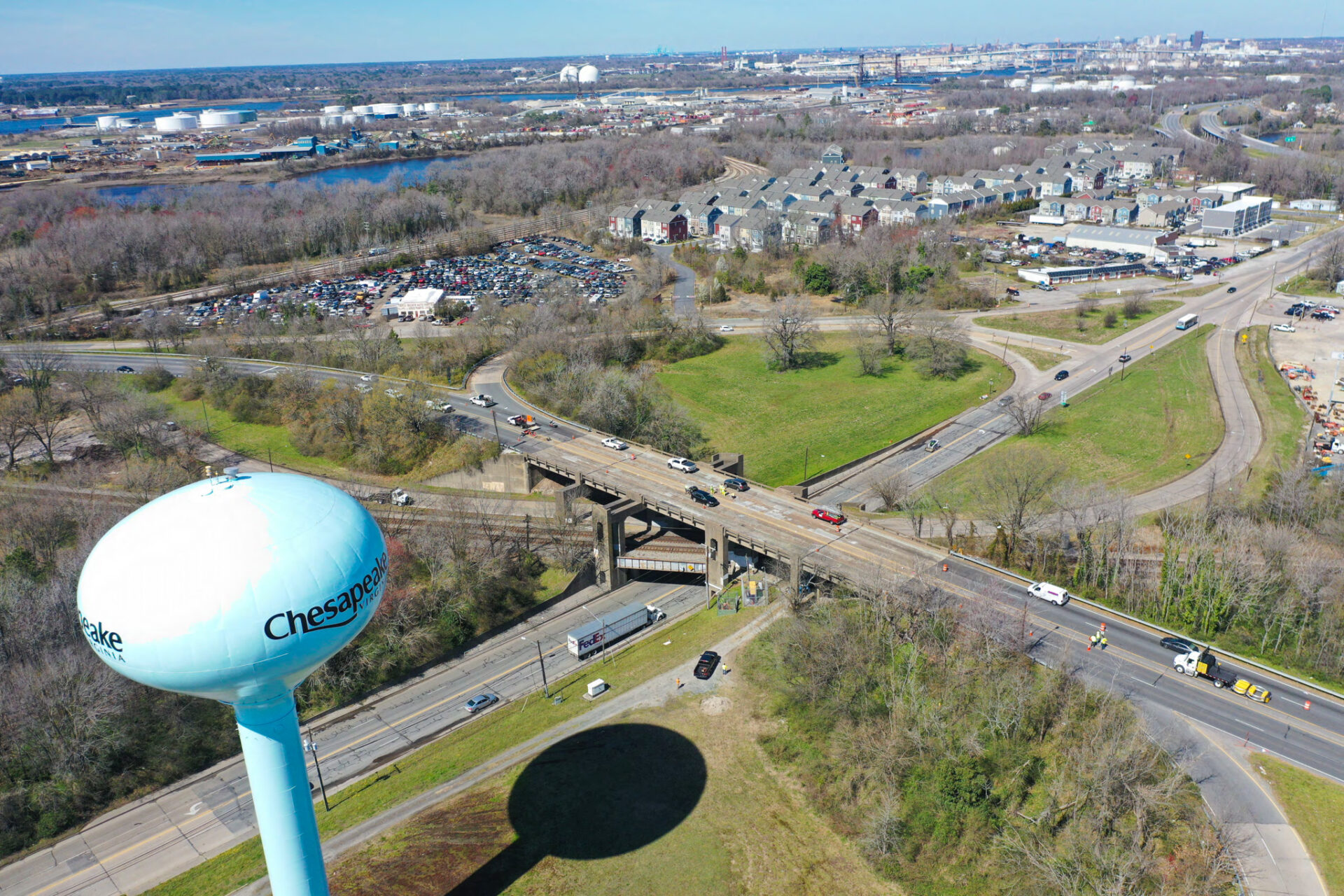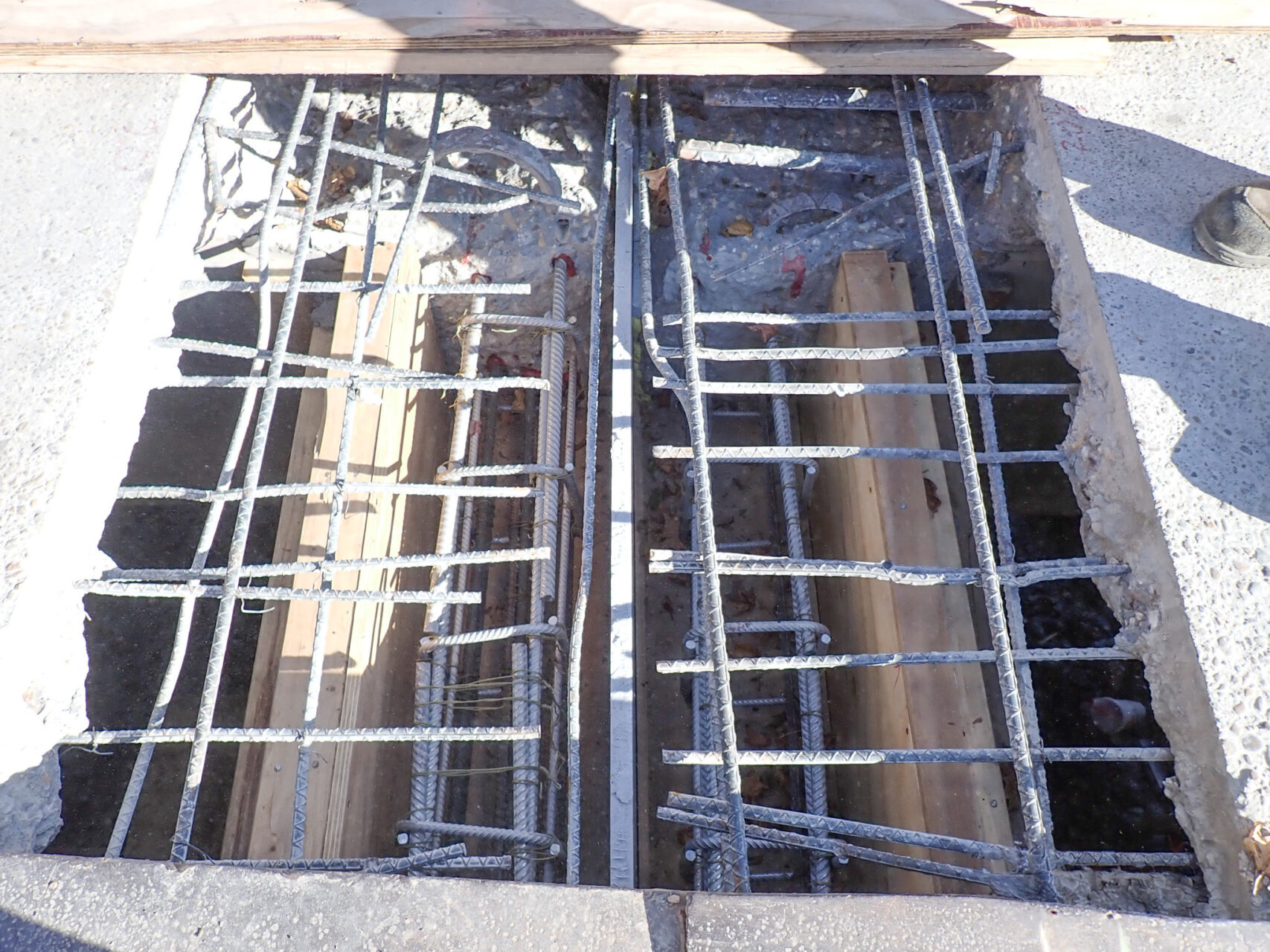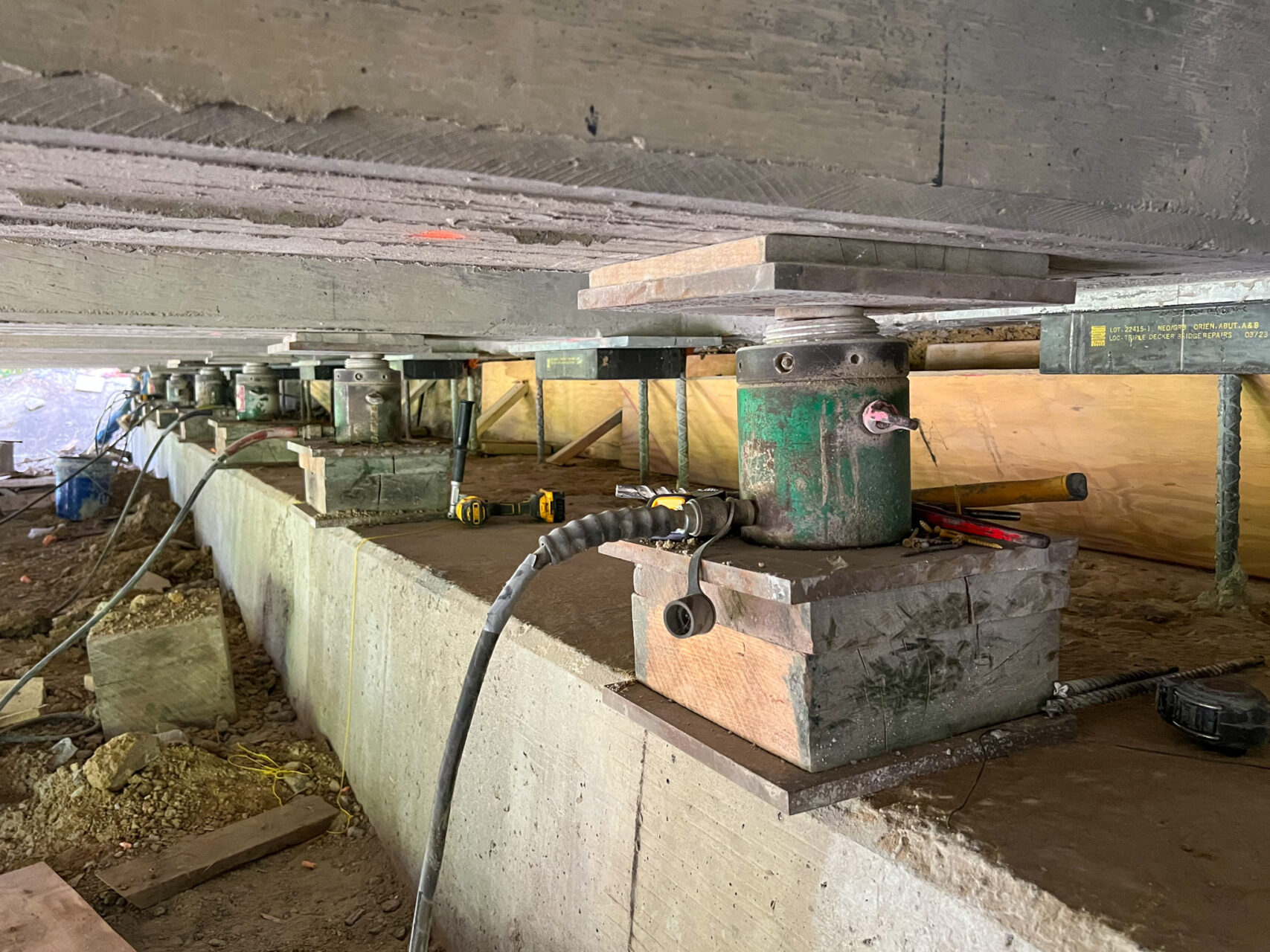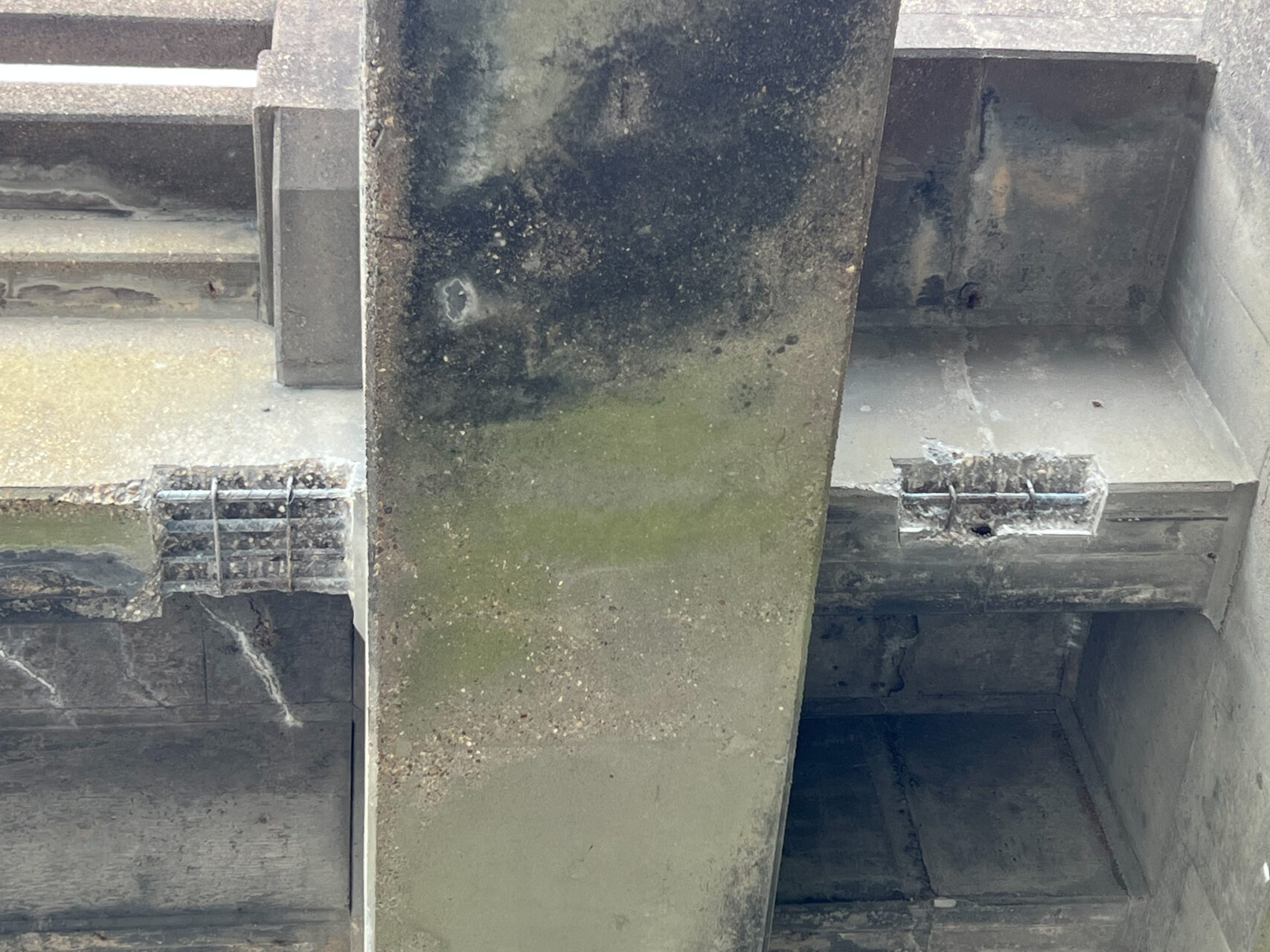Clark Nexsen was the prime consultant and lead designer for the rehabilitation of the Triple Decker Bridge. The bridge was built in 1948 and consists of three levels:
The upper bridge carries Route 13, Military Highway over NS Railway and an exit ramp to Route 166, Bainbridge Boulevard. The structure consists of two simple and five continuous concrete T-beam spans, 271’ long total. The pier caps at the continuous locations are integral with the T-beams, which are in turn integral with the deck.
The lower bridge carries the exit ramp over Bainbridge Blvd and is immediately adjacent to the portion of the bridge carrying two mainline tracks for the Norfolk Southern Railway. This is a simple span steel bridge, but it is highly skewed, with several stringers framed directly into a deep transfer girder on one end and resting on the abutment on the other end. In short, this makes for complex geometry and challenging structural analysis. Furthermore, this bridge carries both roadway and a portion of the railway traffic.
The underpass below the lower bridge, is a pile supported roadway which carries Bainbridge Blvd. The low elevation of the underpass roadway requires a pumping station onsite.
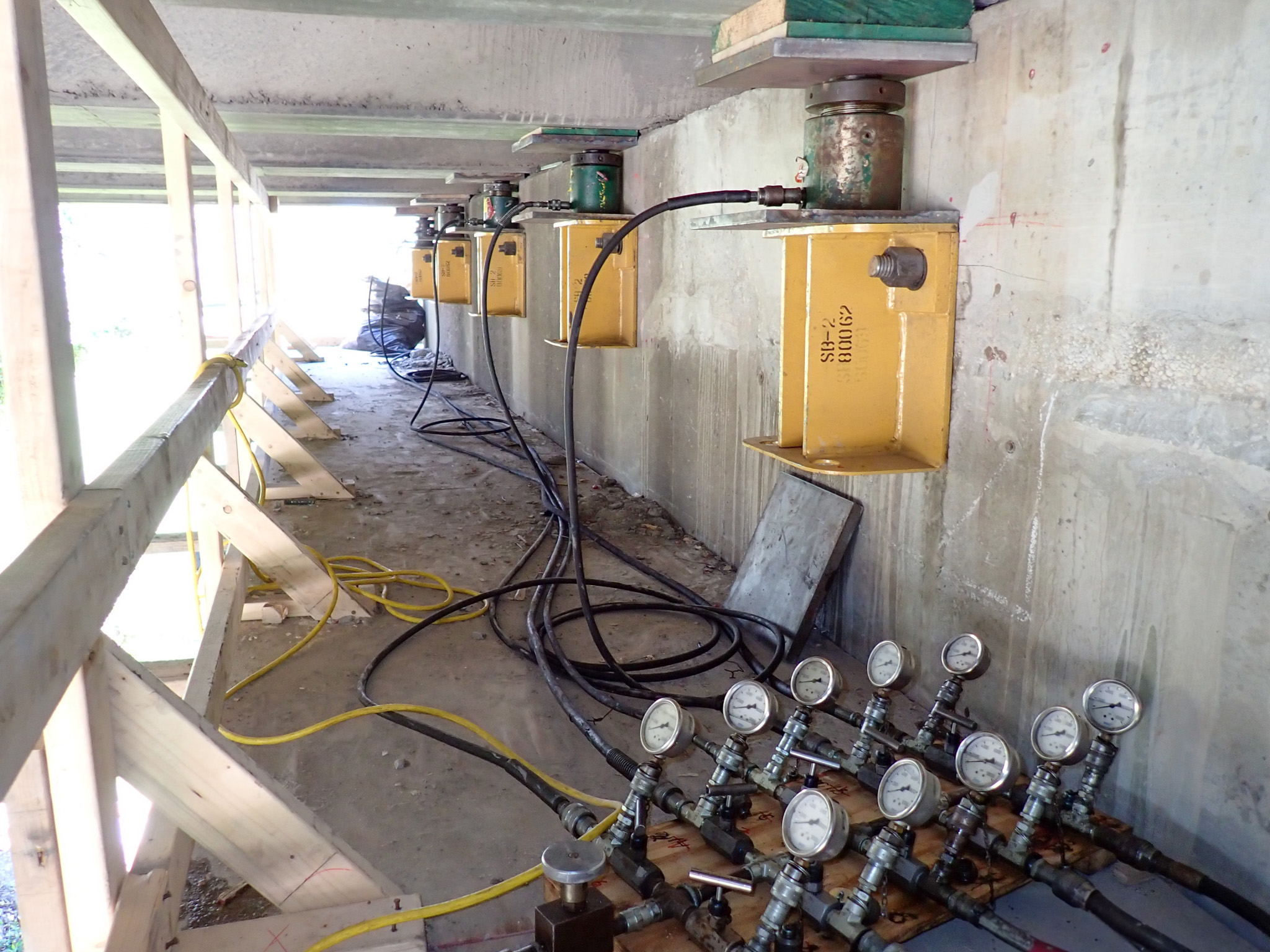 Summary Scope of Work. Our scope was to provide full plans and specifications for the rehabilitation of this complex and historic structure, to restore the condition and enhance the bridge with maintenance reducing components where possible. Analysis and evaluation of the existing undersized pumping station was provided; however, rehabilitation of this element and the pile supported roadway will be addressed in a future project.
Summary Scope of Work. Our scope was to provide full plans and specifications for the rehabilitation of this complex and historic structure, to restore the condition and enhance the bridge with maintenance reducing components where possible. Analysis and evaluation of the existing undersized pumping station was provided; however, rehabilitation of this element and the pile supported roadway will be addressed in a future project.

Preliminary report. A report was provided with alternative rehabilitation choices. Actions evaluated included full superstructure replacement, deck replacement, several deck rehabilitation options, and joint elimination as well as electrochemical chloride extraction of substructure elements.
A notable component of the report was a corrosion analysis of the deck and substructure, which pinpointed intensity of the chloride intrusions and corrosion potentials on the bridge superstructure and substructure, providing us the tools to identify the best rehabilitation options. We selected Vector Corrosion Services VCS to assist us and worked closely together through preliminary and final design.
Rehabilitation design. The design was performed using modern rehabilitation options, which maximize cost efficiency.
Items included deep hydrodemolition to remove poor concrete and simultaneously clean reinforcing steel, with new concrete placed thick, at nearly 4”, thereby fully engaging the top layer of reinforcing steel. Hydrodemolition offers an enormous advantage over removing deteriorated concrete by milling followed by hand demolition using chipping hammers and cleaning the reinforcing steel by media blasting.
Since this approach affected the composite action of the T-beams and integral pier caps at the negative moment regions, care was taken to consider the effect of the demolition on the structure. Selecting deep hydrodemolition allowed for maintaining the integrity of the T-beams with limited shoring while eliminating formwork and providing a durable overlay surface.
Other modern repair techniques included full galvanic corrosion protection using an arc-spray applied zinc coating as well as targeted embedded anodes where needed.
Load Rating. We performed structural analysis for design but also for a load rating of 13 VDOT and 3 City specific permit vehicles.
For the upper bridge, the analysis was complicated by the integral nature of the T-beams and pier caps.
For the lower bridge, the challenging geometry required a 3D finite element model with a full-mesh deck. This model was thoroughly vetted through hand calculations. Furthermore, the railroad live loads (locomotives) and dead loads (ballast) were accounted for in the model.
This 3D model was also used to determine thermal movements, needed to properly design and select the proper bearings to replace the existing bearings at the lower level.
Traffic design. Traffic patterns were not changed. However, due to heavy traffic flow in this area, highly detailed Maintenance of Traffic plans were developed to account for complex phasing during multi-stage demolition, bridge jacking and blocking, and overhead construction and hydrodemolition operations.
Protective Systems. As mentioned above, various tasks are performed over and around live traffic as well as railway traffic. To ensure safety to the traveling public and the surrounding facilities, an emphasis was placed on including protective systems to address items such as hydrodemolition runoff collection and temporary bridge shoring during construction loading and operations.
Construction Administration. We continue to support the city through construction, working closely with the full-time inspection staff. Our primary focus is review of complex submittals such as the Contractor’s jacking and blocking plan, the demolition plan, and review of the shop drawings for detailed items such as the replacement bearings, which critically, must fit the existing bridge dimensions.
Project Funding. The upper and lower bridges and the railroad portion of the lower bridge are three separate structures in the national inventory. Clark Nexsen developed the initial State of Good Repair estimates and applications, working closely with City staff. Two successful funding sources were provided but it was deemed best to present one project for bidding. We provided two plan sets; one for the upper and one for the lower bridges, with all bid items divided accordingly, ensuring the proper UPC could be identified for each related cost.
Overheight Detection. An overheight detection system was also installed to mitigate a somewhat recurring pattern of strikes to the lower bridge.
